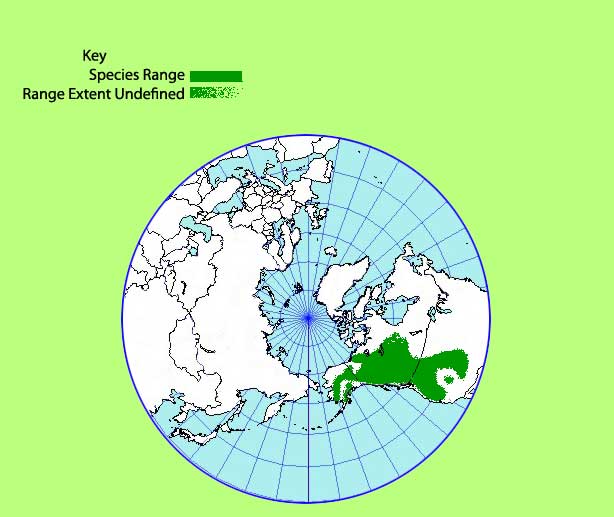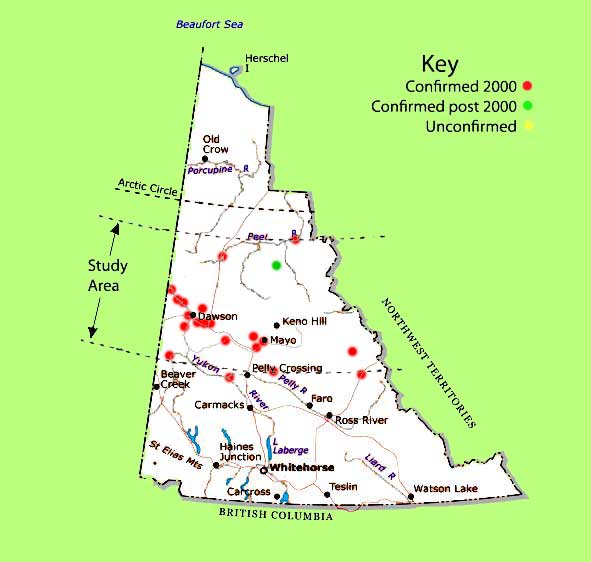Taxonomy
|
Scientific Name:
Kingdom: Plantae
Division:
Class: Dicoteldonae (two seed-leaves) Family: Betulaceae (Birch Family)
Genera: Alnus (Alders) (Ancient Latin name for Alder. Origin and meaning unknown.)
Species: incana (Lat. incana=quite gray.) Synonym(s): A.tunuifolia, A.rugosa English Name(s):
Gray Alder, River Alder, Speckled Alder, Hoary Alder
First Nation Names:
K'oh (Red Willow)
|
Description
|
Structure:
- Plants are monoecious(bi-sexual).
- Medium to large shrub.
- Up to 5 meters tall.
Leaves:
- Alternate, simple (not compound, or lobed).
- Venation pinnate with secondary viens paired.
- 2.5-9cm long by 1.5-6.5cm wide.
- Margins double-serrulate (twice serrated).
Reproductive Parts:
- Flowers imperfect (single gendered) in catkins.
- Male flowers with 4 stamens.
- Catkins on short peduncles (stalks).
- Female catkins 9-15mm long by 8-10mm wide. 3-9 per cluster.
Seed:
- Fruit are numerous small single seeded nutlets.
- Fruiting catkins maturing hard, woody, cone-like and persistent (not falling off).
- Nutlets wingless, merely margined.
Not to Be Confused With:
- A.crispa which can be distinguished by its long peduncled (stalked) catkins and its serrulate (once serrated) leaves.
|
Biology
|
Physiology:
- Caution: Alnus pollen may cause hay fever, or bronchial asthma in some sesitive folk.
- Alders have nodules on thier roots that contain nitrogen-fixing bacteria. When an alder rots, this nitrogen is added to the soil.
- These plants are wind pollenated. Thier pollen grains are so small (0.03mm) they can float long distances on a slight breeze.
Life Cycle:
Seasonal Cycle:
- Catkins appear before the leaves.
- leaves deciduous.
- Cones (fruiting catkins) reach maturity in August.
|
Ecology
|
Animal Uses:
- The pollen is used by bees in spring for brood rearing.
- Bark is chewed by hares and beavers.
- In winter nutlets eaten by many song birds.
- Their buds and twigs make up an important part of the food of ptarmigan and grouse.
Habitat:
- Inducate presence of water.
- Common on riverbanks and lakeshores.
|
Uses
|
Modern:
Industrial:
- Wood burns very hot.
- Wood is soft and fine grained, stains well, developes a nice red tinge with age, used for carving,
Medicinal:
- An infusion of the bark is used as a gargle fortreating sore throat, poor circulation, diarrhea and eye problems.
- Bark (outer & inner) is astringent and powerfully bitter.
- Bark 3.5g boiled in 250ml vinegar is a good remedy for lice. This also makes an excellent mouth wash when diluted with equal parts water.
- Bark is dried and aged for several weeks, then powdered. 30ml powdered bark is mixed with 250ml brown apple cider and 5ml is taken 3 times a day to relieve constipation.
- Leaves applied directly to bare feet in shoes helps with blisters, burning and aching.
- Leaves are used to relieve inflammation.
- Leaves in decoction have been used to soak sore feet.
Food:
- Buds can be eaten.
- Inner-bark can be dried and ground into flour, or chewed as a survival food.
Traditional Gwich'in:
Folklore:
Industrial:
- Bark boiled makes a soluting used to dye hides, skins, snowshoe frames, and fish nets. Hides were soaked for about a day to dye them red.
- Inner bark was made into a pulp and rolled up in a wolverine or beaver skin to make it soft.
- Traditionally used just Alder wood for smoking fish.
Medicinal:
Food:
- Buds and green cones can be chewed and the juice swallowed. This is good juice and good for colds.
Traditional Other:
Folklore:
- Some Dena'ina say it should not be used for cooking meat because a red juice which looks like blood bubles out of it when it is burned.
- In Europe was considered a spirit-haunted tree, and when cut it may begin to , bleed, weep or even speak.
Industrial:
- Inner bark can be boiled to produce an orange dye on hides and a yellow dye on fabric.
- Wood was used in Europe for piles and posts in marshy areas and water troughs, as it was said to endure for long periods under water.
- Green wood with bark removed, is good for smoking meats and fish. It is said to impart a pleasent flavour to the food.
Medicinal:
- Bark decoctions were used to relieve cramps, diarrhea and vomiting, to aid circulation, sooth stomach ache, ease childbirth, stop bleeding, and also to treat eye problems.
- Leaves were moistened with warm milk and used as a poultice to relieve external swellings and inflammation or somtetimes used alone.
- Twig decoctions were drunk as a remedy for impure blood.
Food:
|
|
Images
|
|

Leaf double-serrulate (twice serrated) margin

Cones (fruiting catkins) on short pedicel (stalk).

Catkins early spring.

Illustration from: Illustrated Flora of BC |
Range Maps
|
|

World Range: North American; MB to BC and AK, south to CA and NM.
Prov/State Abrev. List

In Yukon: Common northward to the Porcupine River. |
|





